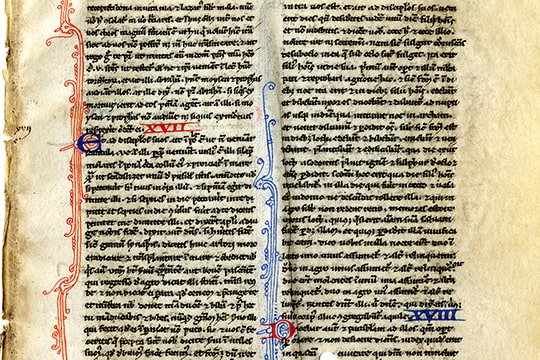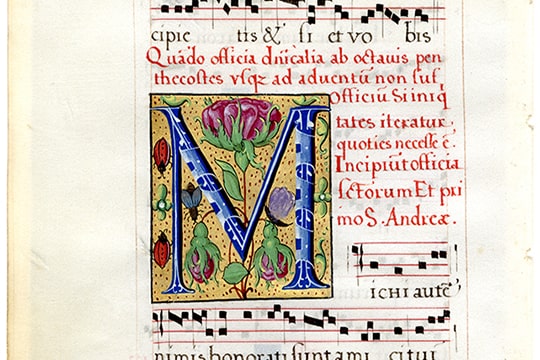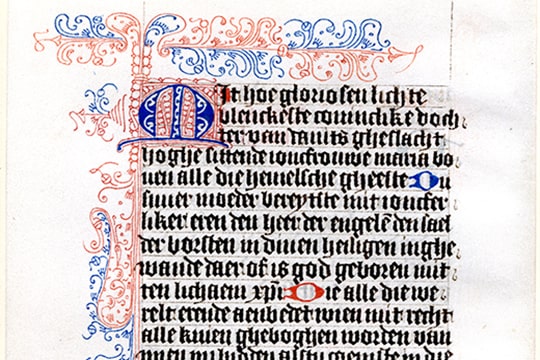The "European Medieval Manuscript Leaves: Varieties of Script and Content from the Jim Sims Collection" is an exhibit of medieval leaves from the 12th to 17th centuries. The exhibit documents an array of Medieval handwriting through the types of books from which the script came. Most of the books are religious in nature, either being liturgical manuscripts, bibles, or private prayer books.
The exhibit is organized online in a variety of ways; through the evolution of Medieval script, through the content of books included, or through the century in which the leaves were created. Each page has a list of related leaves grouped by title on the left side. By clicking on the title of the leaf, you will be led to a more detailed description of the specific leaf along with images.
The leaves are on loan from private collector Jim Sims. He has included a note about the exhibit:
From an early age I have always been a reader and loved books. I had the opportunity to buy my first rare one at the age of 12. It was as exhilarating as it was educational; I learned that rare doesn’t always mean valuable/expensive. I attended college at the Rochester Institute of Technology where I graduated with a degree in Imaging and Photographic Technology; that’s short for scientific photography. My first job out of college was as an engineer working on solutions related to taking 3-D images. My second job out of college ended up being at NASA in Cleveland where the cold winters caused me to start what became my weekly ritual for the seven years I lived there; that is going to the warm & free Cleveland Museum of Art every Sunday. That was my first real exposure to medieval manuscripts and the source of my education in art history. One of their great treasures is the Book of Hours of Henry the VIII’s first wife Catherine of Aragon. I would always run to that display first because every few weeks or so they would turn to a new page. My current trajectory of collecting began when I was sent to a scientific conference held in Santa Fe where I encountered the last brick & mortar incarnation of the Foliophiles business which had been selling single leaves since the 1920s.
Within a couple years I changed both jobs and cities and relocated to the Washington DC area where the opportunities for collecting are tremendous. I befriended a couple key dealers who helped curate and feed my growing passion. I knew I had turned a corner when I found that they were coming to me and asking questions. My collecting is less disciplined than most and centers around what I find most interesting at the moment be that flaws in vellum, scribal errors, or fascinating examples of script. I certainly love a beautiful page and charming decoration, but these can be expensive. I’ve found just as the landed gentry have less interesting biographies than orphans like Oliver Twist, fragments and script tend to be more intriguing than a page that is simply well preserved and beautiful. Perhaps the best stories are whispered.
Among the leaves in this collection the single most valuable was at one time considered scrap and torn from its parent volume and used to cover an accounting book. One rare piece, but not particularly valuable, is the leaf on paper written by a student of Canon law for his own use. Books for personal use, in someone’s own idiosyncratic handwriting and on paper none the less, rarely survive. How and why this one did we can only guess. Notice that the Carolingian Minuscule you see in the oldest texts is the model for the Humanist script you see in the most recent . This in turn becomes the inspiration for the Roman system of fonts that what you are reading now is a direct linear descendant of.
I hope you enjoy the leaves in this exhibition. They were selected specifically to help illustrate different scripts and the evolution of handwriting. It’s a wonderful perspective from which to observe western history. For any would be collectors out there I suggest this; start with handwritten letters and recipes from your grandparents.




